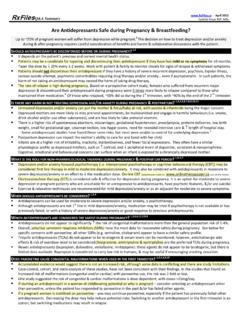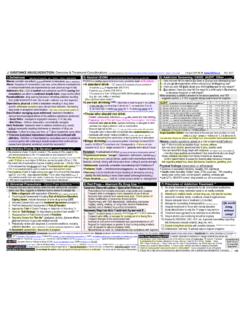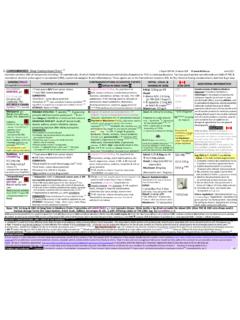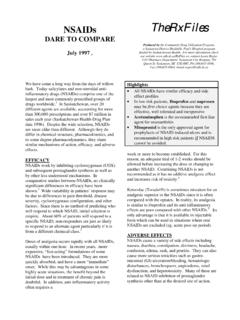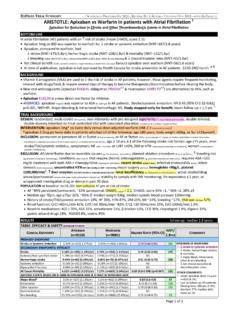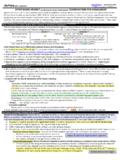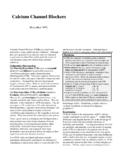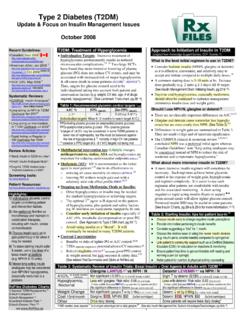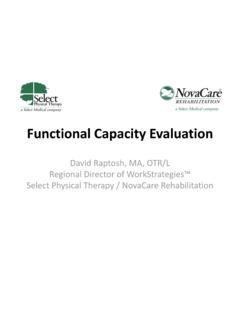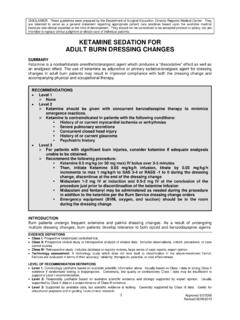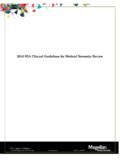Transcription of FIGURE 1: SUPPLEMENTATION EVIDENCE - RxFiles
1 SKELETAL i Hip fractures (NNT 200)with Ca 48-53 1 Falls48-53, 111 1 Osteoar thritis57 i Mor tality (NNT 143)with Ca 48-53 Slight h BMD lumbar spine , forearm, with Ca in steroid-induced osteoporosis55i Mor tality (NNT 290 2-7yrs) 59 n Risk (conflicting results)27,28,58 n Depression treatment78,79 May i Parkinson s progression77n ALS prevention or prognosis84-86 May iMS relapse rate in pts on natalizumab83 Small i in non-specific chronic pain36 OVERALL CANCER RISKI nverse relationship with levels and mor tality: threshold is 20-30ng/mL (50-75 nmol/L) for overall mor tality, 30ng/mL (75 nmol/L) for CV mor tality72,94 n ICU mor tality, length of stay34 MORTALITYNERVOUS SYSTEMBREAST CANCERCOLON CANCERn Risk60 i Plaque psoriasis (but more AE vs steroids) topical vit D39i Winter-related atopic dermatitis in children103 May i inflammatory acne lesions100 Conflicting findings re.
2 Skin aging101,102 SKINMay i prostate cancer progression62 PROSTATE CANCERn CV disease risk(pts were VitD replete)66n BP22 CARDIOVASCULARn T2DM prevention68,69n Non-alcoholic fatty liver disease67 May iT1DM risk in infants22 DIABETES3 Control mineral/bone disorders D2 or calcitriol, stage 3-5 CKD71 May i UTI risk (NNT 175 yrs) largest effects in males99 RENAL i Asthma attacks/hospital visits in mild-mod asthma91n Asthma symptoms/lung function91 n TB sputum culture conversion98 i COPD mod-severe exacerbation risk ONLY in Vit D deficient pts92 (ViDiCo) n Time to 1st mod-severe exacerbation or time to 1st URTI92 (ViDiCo)PULMONARY Small i acute URTI risk(most benefit in very deficient pts and those not receiving boluses)93i Influenza A risk/flu-related asthma attacks in children95 This FIGURE does not include health conditions where a correlation has been observed with Vitamin D levels but not yet tested with Vitamin D SUPPLEMENTATION (these are outlined in Table 2).
3 FIGURE 1: VITAMIN D SUPPLEMENTATION EVIDENCEG reen Text = consistent EVIDENCE from high quality meta-analyses or RCTs Yellow Text = EVIDENCE from RCTs or lower-quality meta-analyses Orange Text = EVIDENCE from observational stud-ies, or RCT EVIDENCE with limitations or inconsistency Pink Text = lack data Skeletal outcomes better studied than other outcome Breast cancer mor tality59 RxFiles Q&A Summary Revised T Rawn Nov 17 Originally Prepared by S Stone, L Regier - Vitamin D: Therapeutic Overview & Evaluation of EVIDENCE for Current Claims 1,2,3,4 Vitamin D deficiency in Canada 5 (see Table 1 below for significance of level) Statistics Canada: 32% of Canadians have levels < 50nmol/L (25% in summer, 40% in winter), and 10% are < 30 nmol/L (mean overall 64nmol/L).
4 42 Symptoms muscle weakness, bone pain Risk factors dark skin, lack of sunlight (northern latitude, atmospheric pollution), sunscreen use (however, sunscreen use is recommended to reduce skin cancer risk), occlusive clothing, elderly, obese or institutionalized, malabsorption ( inflammatory bowel disease, celiac disease), renal disease, medications (anticonvulsants, thiazides,20 corticosteroids, antiretrovirals (HIV), cholestyramine, rifampin) Types of vitamin D - D3 (cholecalciferol) - D2 (ergocalciferol) - Other (active vitamin D analogues) vitamin D3 or cholecalciferol: (preferred form) synthesized normally in the skin via 7-dehydrocholesterol {1000IU of D3 daily will increase 25(OH)D levels by ~15-25nmol/L6 over 8 months} vitamin D2 (or ergocalciferol) a plant based derivative; option for vegans; no longer considered bioequivalent to vitamin D3 calcitriol: one of the active forms of Vit D in the body is calcitriol: used in patients with end-stage renal disease (ESRD) who are unable to convert vit D3 to calcitriol Supplements available in Canada Vitamin D2 and D3 most useful in primary care; other analogues used in specialized areas such as chronic kidney disease.
5 Vitamin D3: OTC: 400IU, 1,000 IU tabs Rx: 2,000 IU cap, 5,000 IU cap, 10,000 IU cap/tab; 25,000 IU cap, 50,000 IU cap, 50,000-75,000 IU manufactured cap from powder vitamin D3: OTC: D-VI-SOL 400 IU/ml, DDROPS (600 or 1000 units/drop5ml=180drops) liquid; OTC Peds: BABY DDROPS : 400 units/drop ~$20 / bottle (~ 90 drops) vitamin D2 Rx: OSTO-D2, D-FORTE 50,000 IU/cap calcitriol Rx: ROCALTROL, generics: , cap (expensive) other expensive Rx: alfacalcidiol ONE-ALPHA ug, ug, 1 ug cap, 2 ug/mL Dosage Guidelines/Considerations Maintenance Range: 400 IU - 2,000 IU daily EVIDENCE supports efficacy & safety of 800 2,000 IU/day for most and possibly up to the daily upper limit of4,000 IU, especially in high risk & in winter.
6 (some suggest Vit D3 10,000 IU weekly or Vit D2 50,000 IU monthly to pill burden) 6 Unit Conversion: 400 IU = 10 mcg (1mcg = 40 IU) 800 IU = 20 mcg 1000 IU = 25 mcg 2000 IU = 50 mcg Osteoporosis Canada guidelines6: adults <50 yrs at low risk for deficiency: vitamin D3 400-1,000 IU once daily adults 50yrs & moderate-high risk: vitamin D3 800-2,000 IU once daily - up to 2,000 IU/day considered safe without requiring medical supervision Max: Vit D from all sources 4000IU/day for all older adults recommended by the American Geriatrics Society 2013 and IOM 2010} adults in long-term care: vitamin D3 800-2,000 IU once daily {if high fracture risk, strongly recommended, otherwise dep.
7 On values/pref/resources}46 Canadian Cancer Society7 adult (during fall & winter): 1,000 IU/day older adults, dark skin or li le sun exposure: 1,000 IU/day all year Canadian Pediatric Society8: pregnancy & lactation: consider 2,000 IU daily especially during the winter breastfed infants: 400 IU/day; 800 IU/day for northern Native communities(especially in winter) formula fed: no supplement needed; except Northern communities 400 IU/day from Oct Apr Scien fic Advisory Commi ee on Nutri on (SACN, UK)45: 4 years: 400 IU once daily IOM 2010: Recommended dietary allowance 1yr = 600IU/day, if 71yr = 800IU/day Vitamin D Bolus doses for severe deficiency may consider initial bolus if serum 25(OH)D level is <25-50nmol/L followed by maintenance lack of EVIDENCE and highly variable in literature and clinical practice approaches vary: {D3 used more than D2; daily 9,10 2,000 4,000 IU daily x 8-20 weeks; weekly 11,12 eg.
8 50,000 weekly x 8 wks (Vit D2 trials); monthly eg. 50,000 monthly x 9; or single bolus 10,000 - 150,000 IU x1 }; may depend on starting 25(OH)D level, BMI, effective sun exposure & other factors eg. malabsorption single yearly high doses (500,000 IU orally or 300,000 IU IM) are not recommended in the elderly due to increased risk of fracture +/or fall esp. in the first few months post dose;13,14 if used, vitamin D3 is preferred over vitamin Vitamin D adverse effects hypercalcemia 15, hypercalciuria GI symptoms (may be due to combination with Ca++ intake) 16 renal disease, nephrolithiasis [400 IU/day + Ca++(~2,100mg/day total avg intake) HR= - 7yrs)39 increased fall & fracture rates with very high single yearly doses of 500,000 IU oral vitamin D314, & similar increases in fractures (not falls) with 300,000 IM Food sources17 {Difficult to get adequate Vit D from dietary sources alone; whereas it is possible to get adequate calcium from diet alone.]
9 } fish: salmon, sardines, tuna & mackerel (200 600 serving)3 & fish oils small amounts found in beef liver, cheese and egg yolks some mushrooms may contain varying amounts of vitamin D2 for fied food sources such as fortified milk/orange juice (8oz glass = 100 IU) Extras: appropriate vitamin D levels may improve absorption of dietary calcium from 10-15% up to 30-40% 3,18 Table 1: Classification of 25-hydroxyvitamin D (25(OH) D) serum levels * (ng/ml x = nmol/L) 25(OH)D (nmol/L) < 3020,42 30-50 20,42,43 50 125 43,44 >12543,44 > 375 50045 Osteomalacia/rickets Poor bone health deficiency ---------------- insufficiency/suboptimal Optimal bone health Potential adverse effects Toxic *Levels not routinely recommended.
10 Useful if high risk of vitamin D deficiency or toxicity , 19,112,113 Cost: $20-60 IOM 2010: 50 nmol/L adequate level (some controversy with US Endocrine Society recommending 75 nmol/L)110 1000IU/day of D3 will increase 25(OH)D levels by ~15-25nmol/L6,20 over 8 months Table 2: Claims and EVIDENCE for Vitamin D (Abridged; for discussion, see reference link to detailed trials summary table21) Category Claims EVIDENCE Prevents hip fractures and mortality 16,22,48-53 Does not prevent falls 23, 24,48-53 Falls/fractures (per 1,000 treated)*:48, 49 (CADTH umbrella review), 50-53 5 fewer hip # (95%CI 2-8) No change in fall risk111 7 fewer deaths (95%CI1-14) CADTH umbrella review of 5 meta-analyses (elderly long-term care population): fall risk only reduced in 1 meta-analysis; others showed no * Benefits only seen when used with Ca++.
